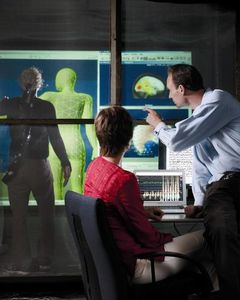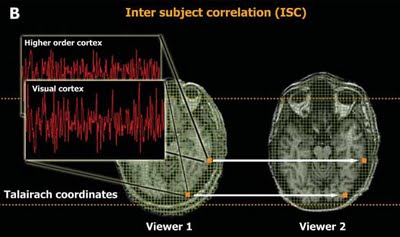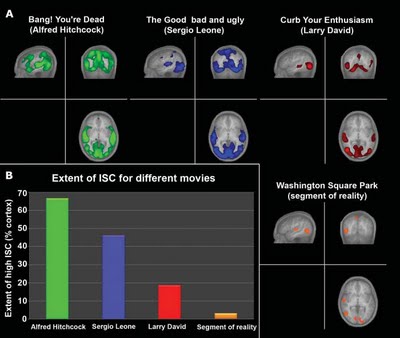Tagged: fMRI
(Il)logical Lindstrom and the iPhone Infatuation

The only thing I love is my iPhone.
Ahh the Apple iPhone: sleek, sexy, and successful–monopolizing the mobile phone industry since its 2007 release. What is it about the iPhone in particular that sets it apart from its competitors, allowing it garner over 60 million followers worldwide? According to “neuromarketer” and consumer advocate Martin Lindstrom, iPhone users should not be considered addicts but rather amorous devotees who literally “love” their device. Now, I understand the dependency characteristic of an avid cell-phone user, whether Apple or otherwise. But as a neuro-nerd, I am obligated to ask: “Where’s the science behind this?” More
Esref Armağan
Most would agree that the most important of our basic senses is sight. Without it, many basic forms of communication fall apart, the vibrance of the world around us dulls, and our understanding and ability to sense the complexity of the physical world diminishes. Without the ability to see, it would logically be impossible to portray our surroundings artistically in a coherent and visually realistic manner...
...wait...what? More
Smokescreen: Scanning the Addict's Brain
The neuroscience of addiction has been extensively studied, giving priceless insight into what is happening in the addict's brain and what keeps people hooked on drug-seeking behavior. Most of the research, though, has been all about the chemical changes in the brain, delving into the molecular level of receptors, neurotransmitters, and reward pathways, etc. But a new approach is being taken from research focusing on extended applications of neuroscience, such as linking neuroscience and "social research and communication studies." In this video, primary researcher Emily Falk explains the work that is being done at the University of Michigan to try to use the brain as a More
Dr. Kent Kiehl Dabbles in Psychopathology
Crime is a trillion-dollar-a-year problem with the average psychopath convicted of four violent crimes by the age of forty. Although psychopathy is one of the least-funded areas of psychology, Dr. Kent Kiehl, one of the leading investigators in this field, hopes to defy this standard.
In January 2007, he requested to have a portable fMRI brought into the Western New Mexico Correctional Facility; the first fMRI ever brought into a prison. Kiehl hopes to test his theory that psychopathology is caused by a defect in the paralimbic system, which is involved in processing emotion, inhibition, and attention control.
 More
More
“Avatar" Virtual Reality: Scientists Explore Self-Consciousness
![]()
In the 2009 film Avatar, scientists exploring the planet Pandora used alien hybrid bodies called "avatars" that functioned through a mental connection established with their genetically-matched human counterparts.
While this kind of technology seems as science fictionally fantastic as only the movies can portray it, recent work in the neuro-scientific community may lead the world to think otherwise. Neurologist Olaf Blanke, with the Brain Mind Institute at Ecole Polytechnique Fédérale de Lausanne in Switzerland, led a Virtual-Reality (VR) experiment utilizing computerized “virtual humans” to gain a deeper understanding of the neurobiological basis for the knowledge of one’s location in space. Interestingly, his team seems to have discovered that the sensation of possessing a body arises as part of our own conscious experience.
Blanke and his team had volunteers wear VR stereoscopic visors, or view projections on a large screen, while the researchers challenged them about fundamental aspects of self perception. The scientists physically touched the subjects either in sync or out of sync with their digital human “avatars” as they wandered through 3D environments, and even ‘immersed’ them into an avatar of the opposite sex. They also changed the subject’s perspective from the first to the third-person point of view. While such methods may seem a bit odd and even unorthodox, the response of the subjects to such testing was both highly positive and truly fascinating. Indeed, as Blanke commented regarding his own observations: "They start thinking that the avatar is their own body; we created a partial out-of-body experience. We were able to disassociate touch and vision and make people think that their body was two metres in front of them".
Throughout the experiement, subjects were fitted with electrode-containing skullcaps to record the electrical activity produced by their brains. The data collected by the electrodes and brain imaging scans (via fMRI) during the study demonstrated a heightened response in the temporo-parietal and frontal regions of the volunteer's brains, areas classically considered responsible for integrating touch and vision. These findings suggest that the subjects' brains were successfully being tricked as they experienced their own "bodies" in virtual space.
Progression in the knowledge of self-awareness and virtual reality could lead to major advances in the fields of robotics, neuro-rehabilitation and even severe-pain treatment. Imagine being able to temporarily “leave” the body as it heals after a serious injury! Though we may never get to explore Pandora, the implications of such out of body "avatar" experiences could be enormous.
Scientists project humans into avatars - Financial Times
Scientists explore the meaning of self-consciousness - Irish Times
The real avatar - EurekAlert
Jazz in an fMRI? An Innovative Look at Creativity and the Brain
We’ve all been exposed to jazz at one time or another—whether it be the musings of an accomplished jazz pianist or the improvisational skills of a saxophone player, jazz is something that’s familiar to us. But, when enjoying such a piece of music, we may not have considered the effect it has on the musician’s brain.
Charles Limb, musician and researcher at Johns Hopkins University, is specifically interested in the workings of the brain during musical improvisation. In order to better understand these mechanisms, he studied the brains of accomplished jazz musicians playing music in an fMRI machine.

The two pillars of his study—playing music which has been memorized and over-learned, and playing music which has been entirely improvised—were designed to pinpoint which brain regions were most active in each situation, as well as to see how differing amounts of creativity play a role in brain activity. Limb asked participants to first play a memorized piece of music on a specially designed keyboard, and then to improvise based on the scale progression of the previous piece.
What he found was quite interesting.
In the studies, Limb observed that, compared to the fMRI of brains playing memorized music, those playing improvised music typically had a higher amount of activation in the medial prefrontal cortex, an area attributed to self-expression, and a lower amount of activation in the lateral prefrontal cortex, an area attributed to self-monitoring. He postulates that in order for an individual to be creative, they must exhibit a sort of dissociation in the frontal lobe by which the large part of the brain controlling self-monitoring is not inhibiting self-expression of new, free-flowing ideas.
More recently, Limb has been studying another form of improvisational music, which he believes serves a similar social function to that of jazz—hip-hop. To do this, he has recruited the talents of accomplished hip-hop artists from the Baltimore hip-hop scene and studied their brain activity while they rap. The structure of the study is similar to that of the jazz pianists in that it was separated into two parts—one to study brain activity while performing a memorized piece and one to study brain activity while improvising. The participants were asked first to rap a piece written by Limb (which they had not seen before), and then to improvise based on a guideline of periodically prompted words. Though the study is not yet complete and no conclusive results are available, what Limb has seen so far has been quite promising.
Outside of Limb's unique research, no extensive work has been done yet to study these phenomena. However, these results prove to be very promising in that they can offer new ways to think about creativity and the brain. Perhaps sometime in the future, with more sophisticated methods of brain imaging, it will be possible to understand the workings of the brain in other creative realms, such as dance. These and many other questions are coming closer to having answers.
Charles Limb: Your Brain on Improv - Video on TED.com
TED Blog - Hip-hop, creativity and the brain: Q&A with Dr. Charles Limb
Further Blending the Arts and Sciences
Ever hear of “neurocinematics" – a term coined by Uri Hasson of Princeton University?
If not, it’s basically a method that has been employed by neuromarketers, using instruments that had been predominantly handled by scientists, that’s targeted towards filmmakers. Using tools such as biometric devices (to track eye movements and heart rate), EEG (to analyze brain waves), and fMRI (to record brain activity), neuromarketers can help filmmakers better understand their viewers’ reactions, whether to completed pieces, screenings, or trailers (the latest Harry Potter movie trailer employed neurocinematics).
predominantly handled by scientists, that’s targeted towards filmmakers. Using tools such as biometric devices (to track eye movements and heart rate), EEG (to analyze brain waves), and fMRI (to record brain activity), neuromarketers can help filmmakers better understand their viewers’ reactions, whether to completed pieces, screenings, or trailers (the latest Harry Potter movie trailer employed neurocinematics).
“Under the assumption that mental states are tightly related to brain states" (a hypothesis that is widely accepted by most neuroscientists and many philosophers), Hasson and colleagues found that "some films can exert considerable control over brain activity and eye movements.”
Neuromarketers ensure the reliability of their findings using several techniques.
To provide a basis for measuring the viewers’ brain activity and to avoid measuring noise dissociated from the task at hand, neuromarketers assess the participant viewers while watching non-stimulating targets (e.g. a standard cross amidst gray background), which should elicit no response. Then, neuromarketers compare this response (or lack thereof) to that elicited from a clip. Some participants may even be asked to watch a clip up to three or four times for comparison purposes.
Because the response of one participant does not say a lot about a clip, neuromarketers use inter-subject correlation analysis (ISC) to ensure further reliability. They can “assess similarities in the spatiotemporal  responses across viewers’ brains,” in which correlations can “extend far beyond the visual and auditory cortices" to other areas, such as the lateral sulcus (LS), the postcentral sulcus, and the cingulate gyrus.
responses across viewers’ brains,” in which correlations can “extend far beyond the visual and auditory cortices" to other areas, such as the lateral sulcus (LS), the postcentral sulcus, and the cingulate gyrus.
In 2008, Uri Hasson and colleagues measured how viewers’ brains responded to different types of films, ranging from real-life scenarios, documentaries, and art films to Hollywood blockbusters. While Alfred Hitchcock's big hit Bang! You're Dead elicited the same response across all viewers in 65% of the frontal cortex, Larry David’s  Curb Your Enthusiasm elicited the same response in only 18%.
Curb Your Enthusiasm elicited the same response in only 18%.
Hasson alleges that the ISC level indicates the extent of control a filmmaker has over his viewers’ experiences, whether intentionally or not, leaving Hitchcock consequently with more control than Larry David.
Hasson’s team also changed the order of scenes for different participants and assessed viewers’ reactions, finding that the more coherent the scene order, the higher the ISC in parts of the brain involved in extracting meaning. Changing the order of scenes can help filmmakers determine which sequence effectively promotes their viewers’ understanding.
Phil Carlsen and Devon Hubbard of MindSign in San Diego, CA. suggest that using neurocinematics can help filmmakers decide which actor will elicit more brain activity from viewers and consequently, give them a better shot in the box office. Not only that, but the method can also help them assign movie ratings, depending on how brain areas associated with disgust and approval respond.
Carlsen has also found, not surprisingly, that 3D scenes activate the brain more so than those of 2D, particularly when viewers used modern polarized glasses over the older blue and red ones.
Neurocinematics has the ability to change the film industry immensely. Whether a filmmaker wants near-complete control or just enough to ensure his message crosses over, he can use this method to make it happen. Even the U.S. Advertising Research Foundation is seriously considering this new method, defining regulatory standards and a quality consult, says Ron Wright of Sands Research.
While some may disagree over whether neurocinematics is killing creativity or invading human interest or personal privacy, others might find it revolutionary, providing filmmakers with more opportunities to create their ideal pieces, and viewers with more engaging, worthwhile films.
Wright, along with neuromarketing consultant Roger Dooley, would likely argue that the method is far from invading human interest or privacy. Wright believes there are too many variables in determining the human  mental “buy button,” which would hypothetically lead someone to spend money – in this case on a film. Dooley does not believe that neuromarketers will “ever find some sort of magic spot that will allow [them] to accurately predict whether someone will purchase a product or not.”
mental “buy button,” which would hypothetically lead someone to spend money – in this case on a film. Dooley does not believe that neuromarketers will “ever find some sort of magic spot that will allow [them] to accurately predict whether someone will purchase a product or not.”
Neurocinematics, agreeable or not, is becoming an important element in the blending of the arts and sciences.
Blending with dozens of other fields and creating amazing products and methods out of doing so, neuroscience, in my opinion, has driven down quite the revolutionary road.
Sources & Additional interesting, related sites:
Songs in the key of EEG – Michael Brooks, NewScientist
Neurocinema – film producer Peter Katz, YouTube
MindSign Neuromarketing -- MindSign
Science of the Movies - MindSign Neuromarketing – Nar Williams, YouTube
DOI: 10.3167/proj.2008.020102) – Hasson, et al., Projections
Brain scans gauge horror flick fear factor – Grace Wong, CNN